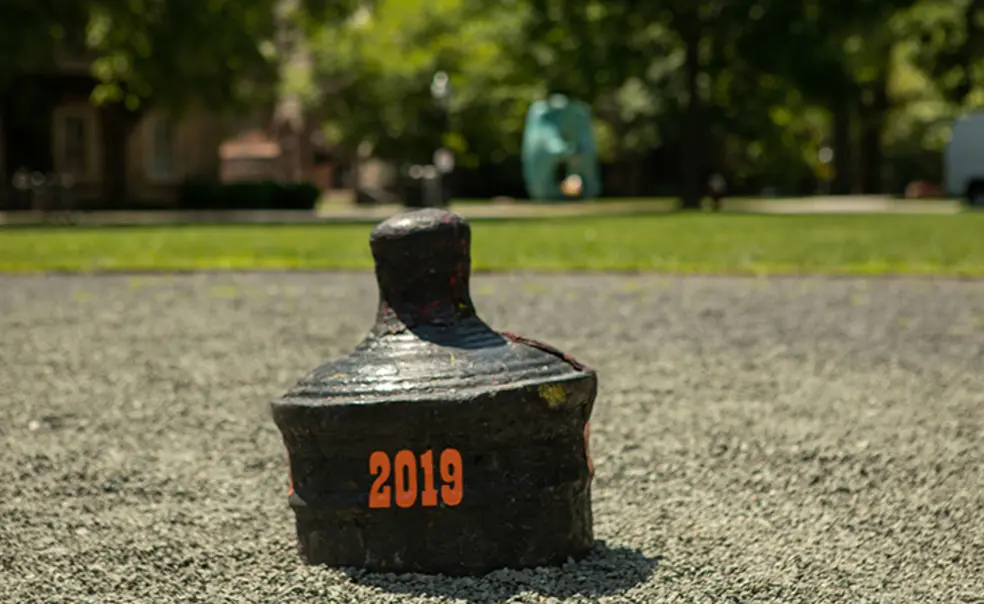Rally ’Round the Cannon: Yore Favorites
There are all kinds of myths that a people has about itself, some positive, some negative, some healthy and some not healthy. I think that one job of the historian is to try to cut through some of those myths and get closer to some kind of reality.
— Professor James M. McPherson, 1995
Today we enter an academic space that is so potentially thrilling or disastrous — or possibly both at once — that almost anyone venturing therein has likely underestimated its potential. We speak of the thought experiment. Like most good stuff the faculty can give you a test on, in its basic organized form the thought experiment (TE) originated with the Greeks, then was given a frightening name by the Germans (Gedankenversuch) to give it scientific legitimacy, then coopted by our faithful Mercer Street friend Albert Einstein when the known universe was inconveniently too small for his ideas. Talk about your pedigrees.
The particular TE that I have in mind (sorry about that …) stems from two entirely separate current activities. The first is discussing the Ukraine war. With a fully professional military in the U.S. since 1973, the confusion of the rest of us over the campaign strategies there is widespread, and the ignorance of weaponry just as bad. So as your token Army veteran, I get to try to explain mortars and Leopard tanks and APCs and rudiments of tactics to various legitimately curious bystanders. The second current issue is the ongoing reconsideration of public historical allusion at Princeton in regard to naming and depiction of various icons, facilities, programs, and organizations; the latest of these is the statue of John Witherspoon on East Pyne plaza. It occurs to me that there are analogous potholes involved in discussing either topic — despite surface dissimilarities — that might be best summed up in an idea from Carl von Clausewitz in the 19th century, more recently repopularized by Vietnam-era Defense Secretary Robert S. McNamara, namely the Fog of War.
And thus the resulting topic for our TE du jour: Is Rally ’Round the Cannon (RRC) an inappropriately narrow, frivolous, warmongerish label for a periodical series intended to investigate the history and traditions of a respected institution, whose informal motto (this week) is “In the Nation’s Service and the Service of Humanity”?
Just to be clear, nobody is pushing this on me or on you, I’m the one who’s asking. And I would further note that if your initial reaction to the question is either “that’s the wokest, lily-livered example of suppressing free speech since Nathan Hale” or “damn the propagandists, defund the military,” then you might wish to continue reading anyway; reintroduce some amount of breadth to your consideration of a university intended to enable open inquiry and the free flow of conflicting ideas, and which inevitably only gets in trouble when it falls short of that.
In considering the RRC label, one might first be concerned about the weaponry. I’ve come to find over the years that an array of readers don’t realize that RRC is an allusion, like East of Eden or Kiss Me, Kate or whatever, so they might deserve some slack on the literary side. Even those who well know “The Cannon Song” (whose chorus begins “Crash through that line of blue …”) often don’t know the line in the verse which goes “With cheers and song we’ll rally ’round the Cannon as of yore,” a literal description of a football bonfire on Cannon Green, penned by then-undergraduates and Triangle Show composers Joe Hewitt 1907 and Rag Osborn 1907, “rally” being used in the sense of a pep rally. With the possible exception of “Old Nassau” decades before, it’s unlikely that any school song has ever overtaken Tigertown with the immediate impact of The Cannon Song in 1906; by the time the composers graduated it had expanded from the stands at football games at University Field to concerts at the Casino and Alexander Hall, and even dances in the gorgeous new University Gym. The lavish 1908 Junior Prom opened with “The Cannon Song” and closed with “Old Nassau.” When the Princeton Band became the first in the country to march onto the sacred gridiron at halftime in 1920, “The Cannon Song” was at the core of its repertoire, along with other compositions from Hewitt and Osborn like “The Guard of Old Nassau”; “Come, Ye Men of Princeton”; “Nineteen Seven’s Back Again”; and “Princeton’s Sons.” Later, Osborn retooled “The Guard …” into “The Princeton Band,” its theme song to this day. The godfather of the Marching Band from its creation, Osborn moved to Princeton when he retired from Wall Street and was its full-time promoter, even starting the Concert Band in 1951 as an offshoot to improve the musical quality and attract a wider range of musicians to the marching plaidfest. So when I suggested RRC as a theme for this column, it wasn’t in recognition of the destructive force of our military traditions or even the weight of history represented (via military hardware) by our dramatic involvement in the American Revolution, but in the undergraduate and alumni spirit of Osborn, Hewitt, their vast cohort, and their enthusiasm for alma mater.
Continuing our TE, a second grumble regarding the RRC title might well be its hardly subtle amount of jingoism. Some of those who don’t even know of “The Cannon Song” have assumed that RRC is a direct allusion to “The Battle-Cry of Freedom,” the propagandistic Civil War song from 1862 by George F. Root which contributed “Rally ’round the flag, boys” to the world lexicon. Like “The Cannon Song” — which borrows its phraseology — it was a huge (and in this case profitable) success from the day it was written. In fact, Root’s rallying cry had such a gigantic impact in the North that it was coopted almost immediately into a Confederate version that still included rallying ’round the “bonnie flag” in the service of the South. To give those TE-imagined suspicious folks their due, this was indeed partially in mind when RRC came about, but not for that expression exactly. When I consider it, I recall Battle Cry of Freedom primarily as the title of Professor James McPherson’s 1988 Pulitzer Prize-winning masterwork on America from 1845-1865 (read it!), which excruciatingly points up the floundering bullheadedness and narrow vision of those in charge on both sides leading up to the Civil War, their resulting assumptions on the precipice of war (the potential of which they couldn’t imagine) and the cataclysm that overtook them all in their own Fog of War. Standing as a vicious rebuke to today’s mindless knee-jerk politics, McPherson’s opus not only remains the preeminent one-volume history of the Civil War, but also stands as a warning for our own time and supposed aspirations. The ultimate caution lies in the genius of his title: both sides paid lip-service to the “battle cry of freedom,” even in the same language, even in the same song. It can be argued that it meant similar hazy ideals to both, but they somehow felt it instead as something to fight and kill over. McPherson’s well-developed sense of irony stands as a not-too-silent criticism of this idiocy (“human frailty” somehow seems inadequate), and I choose to keep it in mind whenever I hear of bruised feelings over campus or alumni goings-on. And a caution for my own writing as well.
So in the end, when I use “RRC,” I try to convey both the Princeton esprit of Rag Osborn (whether with or without the Band’s humor, your call), and also the plea for reason and the caution against mindless mass delusion that permeates the writing and legendary teaching of Jim McPherson. This combo is a tall order, but it’s good to have a stretch goal, as mom used to say. I do, as well, have an additional parting thought, perhaps germane to both Witherspoon’s Revolution and to current-day Ukraine. I am very glad the Cannon in question is buried muzzle down; it’s far more useful as we now consider it that way than it ever could have been in battle.












1 Response
Jeffrey Kehl ’70
2 Years AgoKeep the Name, Gregg!
We’re used to the name; it has acquired “secondary meaning” for us; and one of the nice things about a cannon buried muzzle-down is that it can’t hurt anyone. Just keep writing, please!